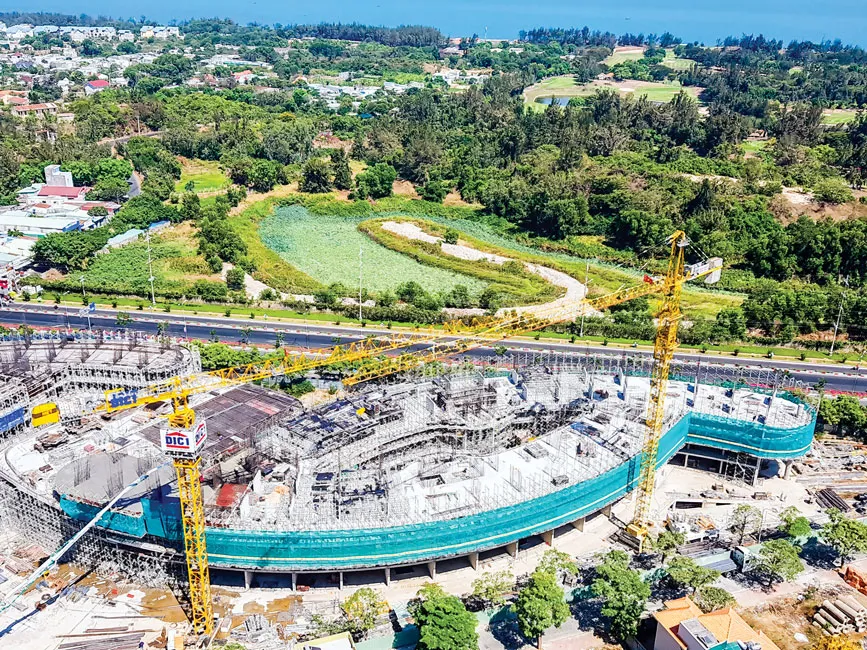
Transformation of company
The branch office of the Vung Tau Tourism and Construction Investment Company was the forerunner of the DIC Investment and Trading Joint Stock Company (DIC- Intraco). The company then upgraded to a 100% state-owned subsidiary from its parent company, the Construction Development Investment Corporation (DIC Corp).
The main business remained construction and installation of civil and industrial projects; trading of construction materials and equipment for construction; exploitation and processing of minerals as construction materials; real estate brokerage and real estate services; warehouse, office, and factory rentals; production of interior materials and color tiles; investment and development of industrial parks; technical infrastructure of urban centers, industrial parks, export processing zones and hi-tech parks.
Initially, the main business of DIC was construction contracts, but the field brought in low profits, hence DIC gradually turned to trading construction materials such as clinker and steel. This became the DIC core business, accounting for 75% of annual revenue. Notably, the supply of clinker is to over 30 grinding stations, accounting for 85% of the market share, going to cement production companies in the southern region such as Ha Tien Cement, 406 Can Tho Cement, Binh Duong Cement, and Can Tho Cement.
According to statistics, DIC clinker consumption reaches about 55,000 tons to 60,000 tons per month. DIC products are even sold in some countries such as Taiwan, Bangladesh, Philippines, China and Singapore. If clinker supply is the biggest revenue earner, steel business is the most profitable area for DIC, thanks to steel supply contracts for constructions of DIC Corp which is its parent company, and also real estate projects invested in by DIC.
Thanks to this timely transformation, DIC maintained an impressive growth rate compared to other peers during the period 2005-2009. Even in 2008, despite difficulties due to interest rates of banks and fluctuations in exchange rates, DIC still maintained profits on total assets (ROA) and return on equity (ROE) at 4.5% and 15.1%, respectively.
Downward spiral
In 2005, DIC was equitized with an initial charter capital of VND 20 bn. Only one year later, DIC put stock on HOSE at a reference price of VND 38,000 per share. Thanks to a stable growth, after listing, DIC continuously issued shares to raise capital and had no difficulty in issuing more shares, specifically in increasing capital from VND 20 bn to VND 33.6 bn in 2007; VND 67.7 bn in 2008; VND 82 bn in 2009; VND 125 bn in 2010; VND 150 bn in 2011; VND 164.4 bn in 2012; VND 170.8 bn in 2013; and VND 265.8 bn in 2015.
Such impressive business results, along with a boom in the stock market in 2007, helped DIC flow with the rising wave and touch a peak of VND 75,000 per share. However, soon after reaching these heights, DIC was sold out and corrected sharply in the following years. The downward momentum increases when enterprises disclose bad information or business results are not as expected. As of now, DIC is only trading around VND 1,500 per share. The decline of DIC price made it difficult for shareholders to withdraw, especially long-term shareholders.
Consequences of past investments
However, the slump in the global financial market in 2008 made DIC reveal its fatal weaknesses. For example, its debt structure was quite high, and added to that were high interest rates that pushed up financial expenses by 180%. By the end of 2008, DIC debt ratio had touched 67%, mainly in short-term loans.
Difficulties continued to grow for DIC when clinker export activities came under pressure with competition due to cheaper supplies from China and Thailand. Even in the domestic clinker market, which was DIC's strength, it became difficult because of oversupply, and as a consequence, its market share plummeted to only 60%. Besides this, there were regulations that caused disadvantages in export tariffs, and increasing price of input materials like petrol, oil, electricity and coal also had an effect.
Faced with the above difficult situation, the Board of Directors of DIC decided to divest in inefficient operating subsidiaries to recover capital and focused on supporting and investing in potential and more feasible goods and projects. However, despite the best of efforts, the results were still modest. By 2011, the Board of Directors of DIC decided to change business strategy and stop implementing real estate projects, and instead focus on developing traditional commercial businesses.
Even though DIC rolled back on any further investments in the real estate market, the consequences of failed past investment projects took their toll and made it impossible for DIC to focus on its main business activities. For instance, the 112 Tran Hung Dao building project in Ho Chi Minh City was a joint project between DIC and the Yen Khanh Production and Trade Services Company Limited, to build a 15-storey building. However, due to some changes made by the Ministry of Defense in the planning stage, both parties had a falling out and stopped co-operating and even took each other to court to settle their issues.
Similarly, in the 25-hectare residential project in Xuan Thoi Son Commune in Hoc Mon District in Ho Chi Minh City, which was a joint project between DIC and the Dai Nguyen Company Limited, both parties landed in court to resolve their dispute, accusing their partner of handing over land that was not as per commitment.




















